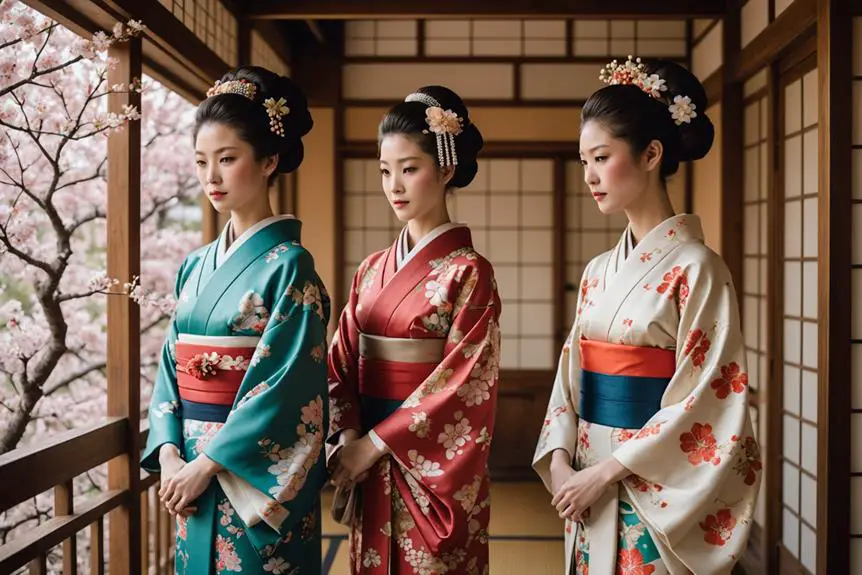When you think about the outfits in "Memoirs of a Geisha," it's hard not to notice how they reflect Sayuri's emotional journey. Colleen Atwood's designs don't just serve as costumes; they act as symbols of transformation, with each color and pattern revealing deeper layers of the characters' experiences. The shift from dark to light kimonos tells a story of hope and resilience. But what does this say about the cultural implications and artistic choices behind these garments? Consider how these decisions shape not just the visual narrative but also our understanding of geisha life.
Overview of Costume Design
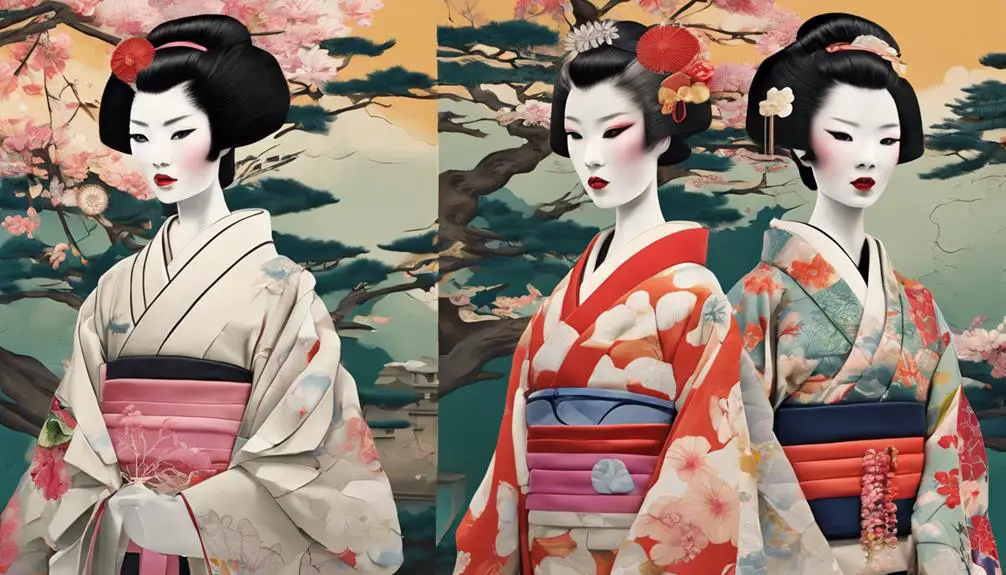
Often celebrated for its stunning visual artistry, the costume design in "Memoirs of a Geisha" plays an essential role in conveying the characters' emotions and narratives. Designed by the talented Colleen Atwood, the costumes won an Oscar in 2005, showcasing their artistic representation and emotional depth. Atwood expertly blended traditional elements with modern aesthetics, creating layered kimonos that not only highlight the intricate art of kimono-making but also elevate the film's visual storytelling. The meticulous attention to detail in these costumes mirrors the craftsmanship found in luxury brands like Ralph Lauren, known for their commitment to quality and heritage, which can also be seen in the identification of vintage pieces.
Each character's unique color palette serves to symbolize their traits and journeys. Sayuri's soft, light colors radiate purity and innocence, drawing viewers into her world, while Hatsumomo's darker hues evoke feelings of bitterness and jealousy, making her complex character palpable. These deliberate choices in costume design enhance the film's emotional resonance and help you connect with each character on a deeper level.
The meticulous craftsmanship behind the costumes is staggering, with a five-month timeline dedicated to creating hundreds of garments. This attention to detail captures the cultural significance of the kimono, allowing you to appreciate the rich history and tradition behind each piece. Atwood's creative liberties, prioritizing visual impact over strict historical accuracy, add a unique flair that makes the costumes unforgettable.
In "Memoirs of a Geisha," the costumes are more than just clothing; they are vibrant expressions of identity, emotion, and culture, inviting you to experience the beauty and complexity of the characters' lives.
Character Costume Highlights
The costumes in "Memoirs of a Geisha" vividly illustrate each character's journey and emotional landscape. You can see Sayuri's character evolution as she evolves from dark, subdued kimonos to lighter, more vibrant silk kimonos, symbolizing her shift from innocence to experience. This transformation captures the essence of her growth, allowing you to feel her struggles and triumphs.
Hatsumomo, on the other hand, wears dark, rich colors that accentuate her bitterness and greed. Her striking dark purple kimono represents her inner turmoil, while the vibrant reds emphasize her beauty and danger, showcasing the complexities of her character. In contrast, Mameha's serene attire features calming colors, reflecting the ideal geisha and offering a stark juxtaposition to Hatsumomo's rebellious fashion.
One of the most memorable moments in the film occurs during the iconic dance scene, where Sayuri dazzles in a dramatic silvery-white kimono with flowing sleeves. The blood-red elements within her costume amplify the emotional impact of her performance, making it unforgettable. Each character's color palette is meticulously chosen, serving as a visual cue to their personalities and emotional states. Sayuri embodies purity and innocence through soft colors, while Hatsumomo's vibrant reds convey jealousy and danger, creating a rich tapestry of Japanese culture that enhances the story.
These costumes aren't just fabric and thread; they're an essential part of the narrative, deepening your understanding of each character's journey and emotions.
Symbolism in Colors
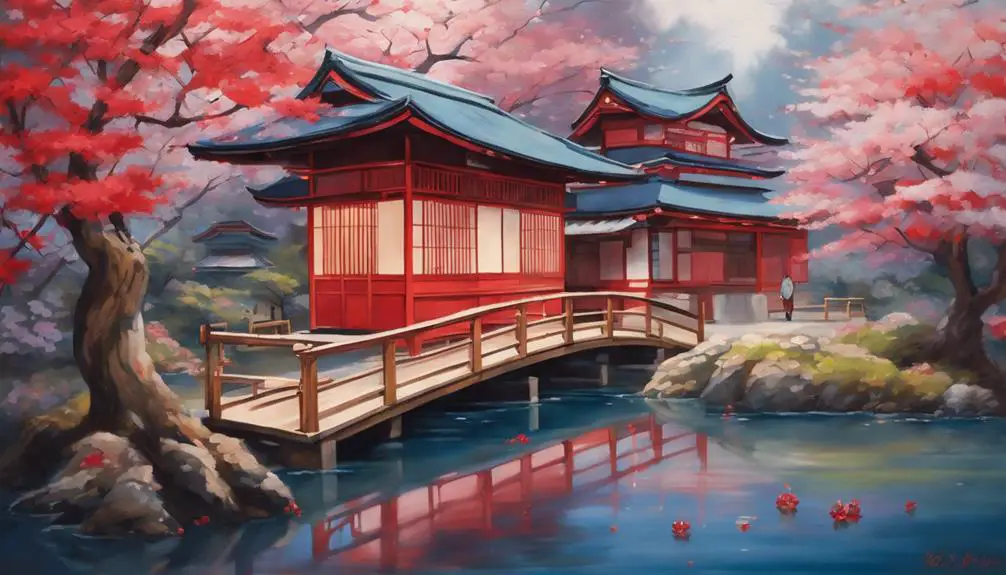
Color symbolism plays an essential role in "Memoirs of a Geisha," enriching the narrative and deepening your connection to the characters. The use of colors in the kimonos throughout the film conveys profound meanings, reflecting each character's journey and emotional state. For example, white is a powerful symbol of both purity and mourning in East Asian culture, encapsulating the duality of Sayuri's life experiences.
Sayuri's soft, light-colored kimonos represent her innocence and purity, while the red accents enhance the emotional intensity of her character, signaling her evolution and growth. The vibrant red collar worn by Sayuri marks her change to full Geisha status, highlighting her newfound identity and elevated social standing. In contrast, Hatsumomo's dark purple kimono symbolizes her bitterness and jealousy, with the rich colors illustrating her internal struggles and the dangers she embodies.
The colors selected for each character align seamlessly with cultural interpretations and serve as a visual narrative, providing insight into their backgrounds and motivations. As you explore the film, you'll notice how these color choices reflect the character arcs, emphasizing the emotional depth and complexity of their stories. Each hue tells a story of its own, allowing you to engage with the characters on a deeper level. Color symbolism not only enhances the visual experience but also enriches your understanding of the themes woven throughout "Memoirs of a Geisha," making it an engrossing journey through identity and emotion.
Artistic Choices in Costumes
Exploring the artistic choices in costumes for "Memoirs of a Geisha" reveals how Colleen Atwood expertly blends traditional elements with vibrant, modern designs. Her work showcases a remarkable ability to prioritize visual storytelling over strict historical accuracy, allowing the film to resonate deeply with audiences. The kimonos, adorned with custom textiles and exaggerated patterns, not only catch your eye but also enhance the emotional depth of the characters.
For instance, the dramatic use of silvery-white and blood-red fabrics during pivotal scenes, particularly in the iconic dance, highlights bold artistic choices that underscore character emotions and narratives. You can truly feel the intensity of the moment, as the vibrant colors evoke a sense of passion and conflict. Hatsumomo's vintage-inspired winter coat, featuring luxurious fur and velvet, demonstrates how Atwood elegantly merges traditional aesthetics with modern embellishments, appealing to contemporary viewers while respecting cultural roots.
The intricate dressing process of kimonos, which could take over an hour, further emphasizes the complexity of these costumes. This attention to detail not only reflects the characters' social status but also their cultural significance, adding layers to their identities. Each costume tells a story, making you appreciate how every pattern and fabric choice is a deliberate artistic decision. Colleen Atwood's costumes are not just outfits; they're integral to the storytelling, transforming "Memoirs of a Geisha" into a visual feast that captures the essence of its characters.
Reception and Critique
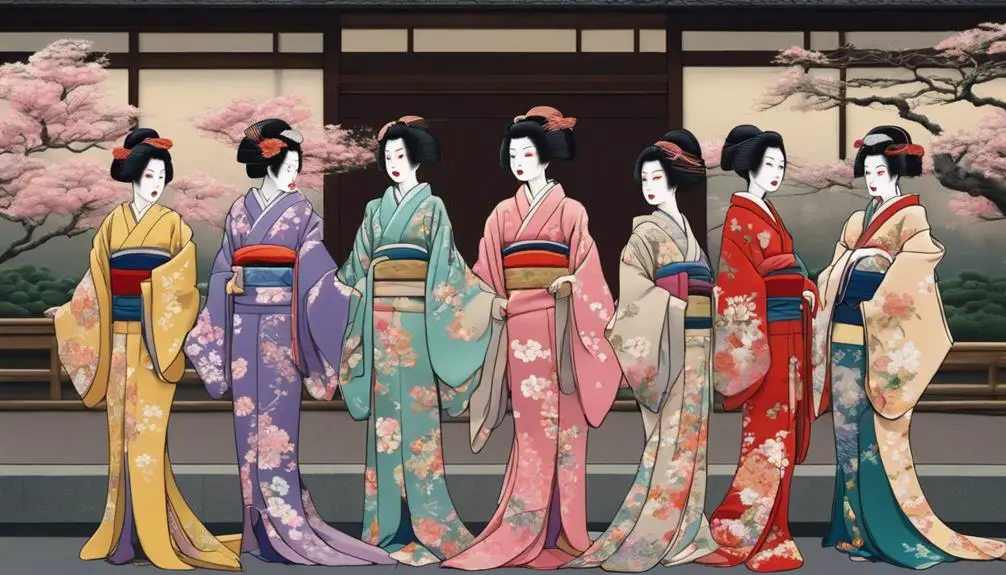
Colleen Atwood's costumes in "Memoirs of a Geisha" not only drew attention but also sparked significant discussion among critics and audiences alike. The beauty and intricate detail of these costumes received widespread acclaim, contributing immensely to the film's overall aesthetic. Critics praised Atwood for striking a balance between traditional Japanese attire and artistic expression, showcasing her creative vision while respecting cultural tradition. Vogue even described the costumes as an inspired riff on this rich heritage, emphasizing how they enhance the film's narrative impact.
Entertainment Weekly highlighted that the thoughtful costume choices dramatically enhanced crucial moments in the film, reinforcing character arcs and adding layers of emotional depth. You might notice how costumes evolve alongside the characters, reflecting their journeys and transformations. While some knowledgeable viewers recognized inaccuracies in geisha attire, many appreciated the costumes as essential tools for understanding the characters and themes presented throughout the story.
In essence, Atwood's artistic expression through these costumes is more than mere decoration; they serve as a visual language that communicates the emotional states and cultural context of the characters. The costumes in "Memoirs of a Geisha" are an unforgettable aspect of the film, inviting you to experience the intricate world of geishas in a way that is both enchanting and thought-provoking. The blend of tradition and innovation creates a lasting impression, ensuring that Atwood's work will be remembered as a significant contribution to cinematic costume design.
Costume Inaccuracies Explored
While the costumes in "Memoirs of a Geisha" are visually stunning, numerous inaccuracies in their portrayal of geiko and maiko attire can't be overlooked. The film presents an image of geisha culture that's enthralling, yet it strays from the traditional elements that carry deep cultural significance. For instance, the hairstyles featured in the film don't align with historical styles that have specific meanings and vary by season or occasion. These inaccuracies dilute the essence of what geiko and maiko represent.
Moreover, during the Snow Dance scene, the attire and dance style depicted diverge from authentic practices, which can mislead viewers about the true nature of geisha artistry. While the film aims to showcase the beauty of kimono, it fails to accurately reflect the layers of meaning associated with the designs and colors. Each kimono tells a story, and the choices of fabric and hue are steeped in tradition, elements that the film glosses over.
Interestingly, modern geisha do incorporate traditional aspects while adapting to contemporary life, creating a fascinating blend of styles. However, "Memoirs of a Geisha" tends to overlook these nuances, opting for a more stylized approach that doesn't capture the full spectrum of geisha attire. As you explore the world of geisha culture, acknowledging these inaccuracies helps you appreciate the intricate beauty of their traditional attire even more.
Cultural Significance of Geisha Attire
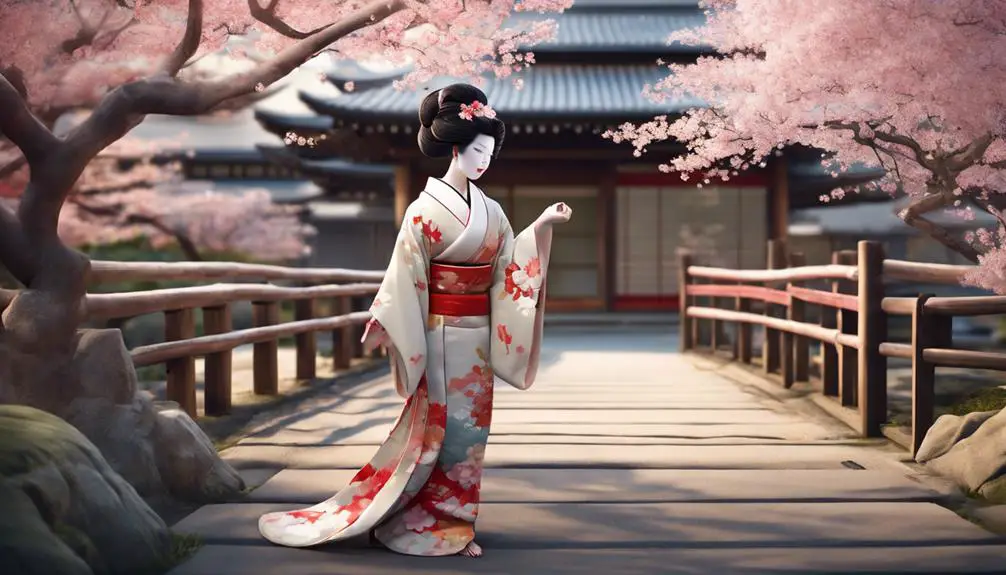
The inaccuracies in costume portrayal highlighted in "Memoirs of a Geisha" underscore the importance of understanding the cultural significance of geisha attire. You'll find that this attire is more than just beautiful silk kimonos; it represents a rich cultural heritage and the artistic traditions of Japan. Each garment is meticulously crafted, reflecting the skill and dedication of those who create them.
The colors and patterns in geisha costumes are not random; they often signify a woman's status and experience within the geisha community. For instance, vibrant hues like red can indicate a shift to full geisha status, showcasing the deep-rooted social hierarchy that exists among these artists. Layered kimonos and various accessories serve to denote different levels, making attire an essential part of their identity.
Moreover, the elaborate hairstyles and makeup associated with geisha attire require rigorous training and precision, emphasizing the dedication to maintaining authenticity and artistry. This attention to detail guarantees that geishas embody the traditional Japanese beauty that's celebrated both locally and globally.
Frequently Asked Questions
What Is the Age Gap in Memoirs of a Geisha?
In "Memoirs of a Geisha," age differences markedly shape relationship dynamics and character development. You see how societal expectations and cultural perceptions influence personal growth, reflecting historical context and the journey from innocence to experience.
Is Memoirs of a Geisha Culturally Accurate?
You'll find "Memoirs of a Geisha" blends artistic interpretation with cultural representation, often sacrificing film accuracy for visual appeal. While it showcases geisha traditions, it strays from historical context, raising concerns about cultural appropriation and societal norms.
How Old Is Sayuri at the End of Memoirs of a Geisha?
At the end of "Memoirs of a Geisha," Sayuri's age is around 30. Her journey through geisha training, emotional growth, and historical context highlights her love interests and personal sacrifices, showcasing the cultural significance of her experiences.
What Does Danna Mean in Memoir of a Geisha?
In "Memoirs of a Geisha," a danna relationship represents complex love dynamics within geisha traditions. Sayuri's training highlights emotional sacrifices, illustrating cultural symbolism and power dynamics inherent in these patronage arrangements that shape her life.
